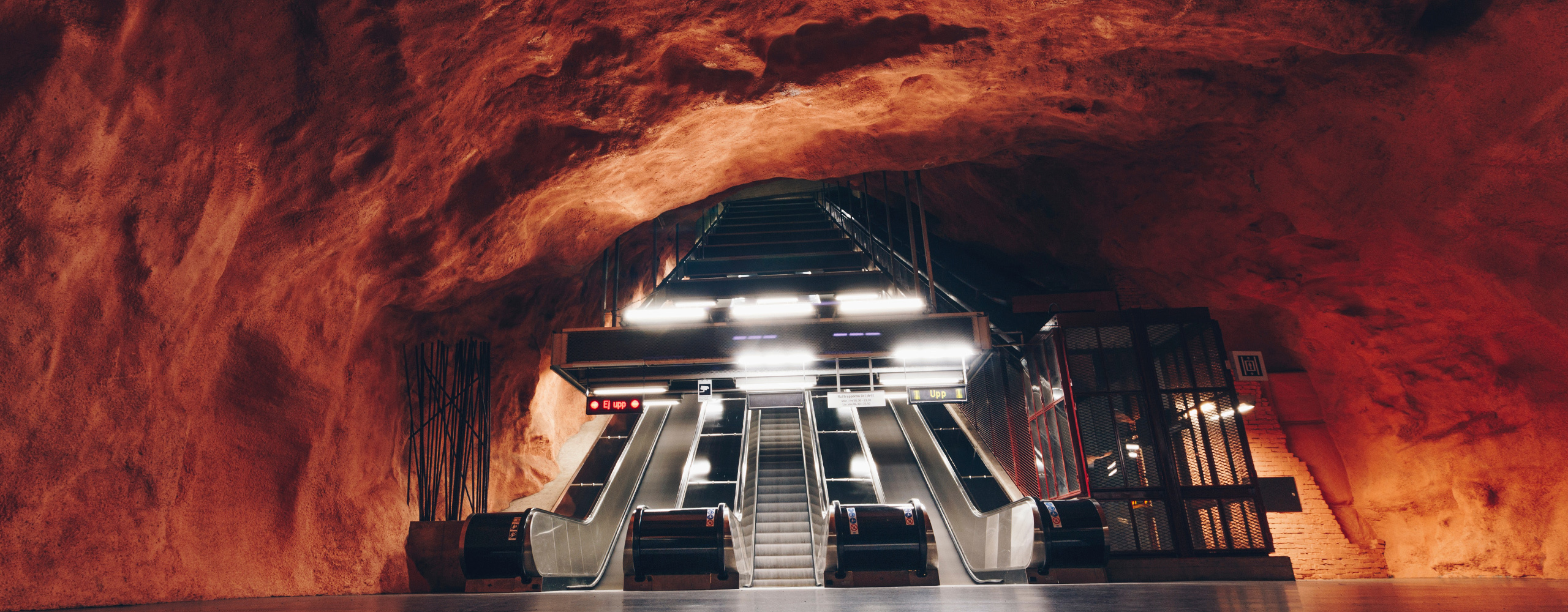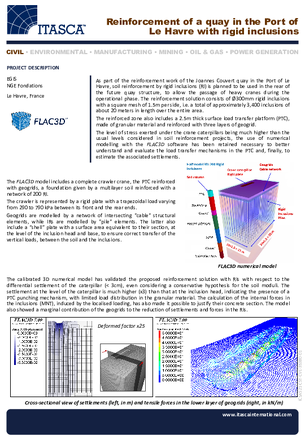
Reinforcement of a quay in the Port of Le Havre with rigid inclusions (2023)
Dans le cadre des travaux de renforcement du quai Joannes Couvert au Havre, un renforcement de sol par inclusions rigides (IR) est prévu à l’arrière de la future structure de quai pour permettre la circulation de grues lourdes lors de la phase d’exploitation.
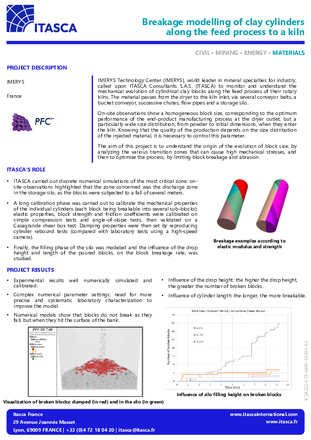
Breakage modelling of clay cylinders along the feed process to a kiln (2022)
IMERYS Technology Center (IMERYS), world leader in mineral specialties for industry, called upon ITASCA France (ITASCA) to monitor and understand the mechanical evolution of cylindrical clay blocks along the feed process of their rotary kilns. The material passes from the dryer to the kiln inlet, via several conveyor belts, a bucket conveyor, successive chutes, flow pipes and a storage silo.
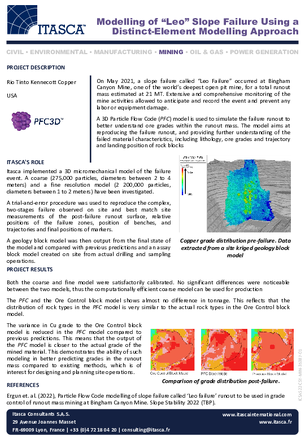
Modelling of “Leo” Slope Failure Using a Distinct-Element Modelling Approach (2022)
On May 2021, a slope failure called “Leo Failure” occurred at Bingham Canyon Mine, one of the world’s deepest open pit mine, for a total runout mass estimated at 21 MT. Extensive and comprehensive monitoring of the mine activities allowed to anticipate and record the event and prevent any labor or equipment damage.
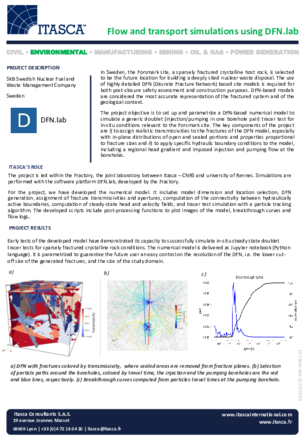
Flow and transport simulations using DFN.lab (2022)
In Sweden, the Forsmark site, a sparsely fractured crystalline host rock, is selected to be the future location for building a deeply sited nuclear waste disposal. The use of highly detailed DFN (Discrete Fracture Network) based site models is required for both post-closure safety assessment and construction purposes. DFN-based models are considered the most accurate representation of the fractured system and of the geological context.

Site modeling using DFN.lab (2021)
In Sweden, the Forsmark site, a sparsely fractured crystalline host rock, is selected to be the future location for building a deeply sitted nuclear waste disposal. The implementation of highly detailed, and DFN (Discrete Fracture Network) based, site models is required for both post-closure safety assessment and construction purposes. DFN-based models are considered as the most accurate representation of the fractured system and of the geological context.
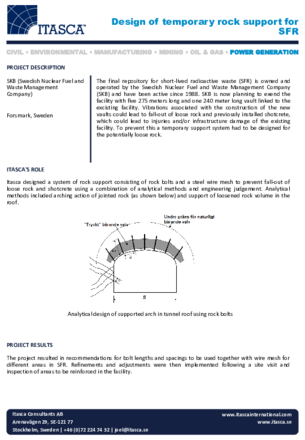
Design of temporary rock support for SFR (2021)
LKAB’s Kiirunavaara Mine is a large, underground, sub-level caving mine that has been seismically active since approximately 2008. With this seismic activity comes associated vibrations. These vibrations can be felt on surface in the town of Kiruna, which is currently located close to the mine on the hangingwall side. The mine is undergoing a national permitting process concerning a desired increased production rate. An important question for this process is: will the increased production rate result in changes to vibrations in the town due to seismicity?

Effective elastic properties of fractured rocks (2021)
The objective of the project is to predict the scaling evolution of rock mass effective elastic properties for conditions relevant to the POSE (Posiva’s Olkiluoto Spalling Experiment) niche surroundings at ONKALO, the Finnish site for underground storage of nuclear waste.

Simulating Spalling With a Flat-Jointed Material (2020)
Long-term storage of spent fuel is critical to the nuclear energy industry. The Swedish Nuclear Fuel and Waste Management Company (SKB) is developing an approach for the storage of spent nuclear fuel in an underground repository in competent crystalline rock. In order to better understand the spalling damage process, an in-situ test involving the drilling of two boreholes was performed in Äspö diorite at SKB’s underground hard rock laboratory in Äspö. Tests and monitoring were performed on the pillar that separated the boreholes. In order to further investigate the damage process, Itasca performed numerical modeling using PFC3D and FLAC3D.

Conditioning DFN models by GPR data (2020)
As part of the EU Horizon 2020 ENIGMA ITN project, ICSAS, the CNRS, and SKB proposed a PhD project entitled “Flow and transport in fracture networks: reducing uncertainty of DFN models by conditioning to geology and geophysical data”, to develop and test a methodology for rock characterization that would help in the decision-making process for an adequate location of the nuclear waste canister burying.

Modeling of Spalling in PFC3D — A Quantitative Assessment (2020)
SKB is interested in developing a 3D discrete model to predict spalling on the excavation boundaries of underground repositories for the long-term storage of spent nuclear fuel. This project provided a quantitative assessment of modeling spalling using PFC3D to study both lab- and tunnel-scale behavior.

Seismic Performance of the OPC Puerto Cortes Container Terminal in Honduras (2019)
Itasca conducted a seismic performance evaluation of the trestle‐wharf section of the OPC Puerto Cortes Container Terminal, located in Honduras. A FLAC3D analysis of the soil is performed, including the piles and deck of the terminal. This is a fullycoupled, dynamic, soil‐structure, time‐history analysis that quantifies the performance and potential risks for the structure and slope. The Finn model – Byrne formulation was utilized using data from investigation boreholes.

Estimation des tassements dus à une excavation complexe (2019)
Dans le cadre des travaux du Grand Paris, le groupement VINCI-SPIE construit la future gare du RER E sous La Défense. Dans ce projet, la zone Avant-Gare (AG) Ouest (Fig. 1) est rendue complexe par son phasage et les nombreuses structures avoisinantes, telles que la ligne T2, les fondations d’un bâtiment emblématique de la Défense, le CNIT, et de son parking.
VINCI a demandé à ITASCA de réaliser un modèle 3D pour le calcul des tassements de surface engendrés par les excavations. Le modèle prend en compte le phasage réel de l’ensemble des travaux prévus.

Estimating settlements due to a complex excavation (2019)
In the context of the Greater Paris works, the VINCI-SPIE group builds a future metro station underneath the CNIT centre in Paris, for the westward extension of RER E (EOLE). The West Pre-Station is particularly complex due to its excavation phasing and the presence of many surrounding structures, including among others the T2 tramway line and several foundations.

Modelling over-boring and extension of a tunnel with surrounding excavations (2018)
Dans le cadre du chantier 4 d’extension du laboratoire souterrain de Meuse/Haute-Marne, une niche de sécurité (appelée GT1) de section type
S1 sera alésée puis prolongée avec une section S4. L’axe de ce tunnel est à 16m de l’axe du Puit Auxiliaire (PX).

Penetration of a Single Steel Foundation Pin in a Granitic Rock (2018)
The development of a subsea tidal turbine requires specific research work concerning the design of the foundation in contact with the seabed. This design stage can be simplified by the use of numerical modelling and more particularly by using discrete modelling. HydroQuest asked Cathie Associates to check their previous calculations regarding the behavior of a single steel foundation pin in a granitic rock mass by using Itasca’s discrete numerical approach and follow the forces applied to the pin as well as the state of the damaged zone around the tip during penetration.
